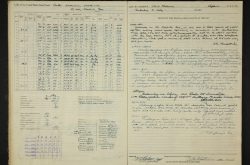
Our knowledge of sea ice in the Arctic Ocean comes mostly through satellites, which since 1979 have imaged the dwindling extent of sea ice from above. The University of Washington’s Pan-Arctic Ice Ocean and Modeling System, or PIOMAS, is a leading tool for gauging the thickness of that ice. Until now that system has gone back only as far as 1979.
A new paper now extends the estimate of Arctic sea ice volume back more than a century, to 1901. To do so it used both modern-day computer simulations and historic observations, some written by hand in the early 1900s aboard precursors to today’s U.S. Coast Guard ships.
“In the logbooks, officers always describe the operating conditions that they were in, providing hourly observations of the sea ice at that time and place,” said co-author Kevin Wood, a researcher at the Joint Institute for the Study of the Atmosphere and Ocean. If the ship was in open water, the logbook might read “steaming full ahead” or “underway.” When the ship encountered ice, officers might write “steering various courses and speeds” meaning the ship was sailing through a field of ice floes. When they found themselves trapped in the ice pack, the log might read “beset.”
These logbooks until recently could only be viewed at the National Archives in Washington, D.C., but through digital imaging and transcription by Old Weather citizen-scientists these rare observations of weather and sea ice conditions in the Arctic in the late 1800s and early 1900s have been made available to scientists and the public.
“These are unique historic observations that can help us to understand the rapid changes that are taking place in the Arctic today,” Wood said.
Read more at UW News »
